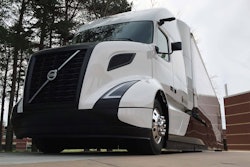
Last year, the National Highway Traffic Safety Administration reached an agreement with most prominent U.S. automakers that will make automatic emergency braking (AEB) a standard feature on all new vehicles by the 2022 model year.
An AEB system, which works on trucks equipped with disc or drum brakes, alerts the driver that corrective action is needed to avoid a rear-end crash. If the driver’s reaction is insufficient, the AEB system can automatically apply the brakes to help prevent or reduce the severity of impact.
“We’ve really got a lot of OEMs on the tractor side that have made collision mitigation systems standard on their vehicles,” says Fred Andersky, Bendix’s director of government affairs.
Volvo Active Driver Assist, the fully integrated Bendix Fusion system, is standard on the VNR regional haul and VNL long-haul models. This week, Mack Trucks announced Bendix’s Wingman Fusion will come standard on all Anthem trucks. Also as of this year, Bendix Wingman Advanced is standard on the Peterbilt Model 579, Kenworth T680 and International LT trucks.
“To an extent, this may be the first time the trucking industry might actually be ahead of the automotive industry in terms of making a technology standard.”
If the AEB system – which is always on and can’t be disabled – determines a crash in imminent, it first alerts the driver action is needed.
“The benefit of the system is that it provides a reaction time that is superior to what most humans can,” says Wabco President, Americas Jon Morrison. “From a view of a constant scanning of the horizon and being able to react very quickly, that is a benefit.”
Andersky says in Bendix’s Wingman Fusion, a radar and a camera system work together to provide information to the engine control unit (ECU).
“The radar sees the metallic object in front of us and the camera confirms that it’s a vehicle,” he says. “The algorithms in the ECU sit back and make a decision in terms of ‘what do we need to do?’”
If the driver doesn’t react – or reacts to a degree the system determines unlikely to avoid impact – the system can cut the truck’s throttle and apply the brakes on the steer, drive and trailer axles.
“If Detroit Assurance senses a partial or full braking event is about to happen, the system triggers the transmission to downshift or shift into neutral depending on whether the truck is going uphill or downhill, what kind of load it is carrying,” says Kelly Gedert, director of product marketing for Freightliner Trucks and Detroit, “and how much Detroit Assurance needs to decelerate to mitigate a potential collision.”
The AEB system is built on top of the truck’s stability control platform and is integrated with its anti-lock brakes, ensuring that an emergency stop doesn’t cause a rollover accident.
“Active Brake Assist (ABA) and stability control work together in that stability control would, for example, prevent ABA carrying out a full braking maneuver in an icy curve,” Gedert adds. “Stability control would not let ABA do something that would cause the truck to tip over.”
Andersky notes that AEB is a driver assist, not a driver replacement, feature and that even when the system indicates a braking event lies ahead, the final decision lies with the driver.
“We’ve got to rely on the fact the driver is controlling the vehicle and has an intent of what he or she wants to do,” he says.
“The philosophy remains to get the driver reengaged in the process,” adds Morrison. “We want to make sure if they need to have an evasive maneuver, or if they need to brake in a certain way, that they have the first chance of reacting.”
Andersky says the Bendix platform will alert the driver, then apply the brakes for about 1.2 seconds with the goal of getting the driver’s attention so they driver can decide what needs to be done.
“If the driver keeps their foot on the accelerator, that’s telling the system that the driver has a reason for doing this,” Andersky says. “Maybe he’s building up speed to make a rapid lane change to avoid a potential collision. We return control back to the driver to let them finish the maneuver.”
As of next month, electronic stability control will be mandated on all new heavy trucks. However, Morrison says he doesn’t see a similar mandate for collision avoidance.
He says more fleets are voluntarily adopting collision mitigation technologies, including Wabco’s OnGuard platform, with market penetration reaching upwards of 15 percent.
“It’s not moving toward any kind of regulation anytime soon,” Morrison says.











